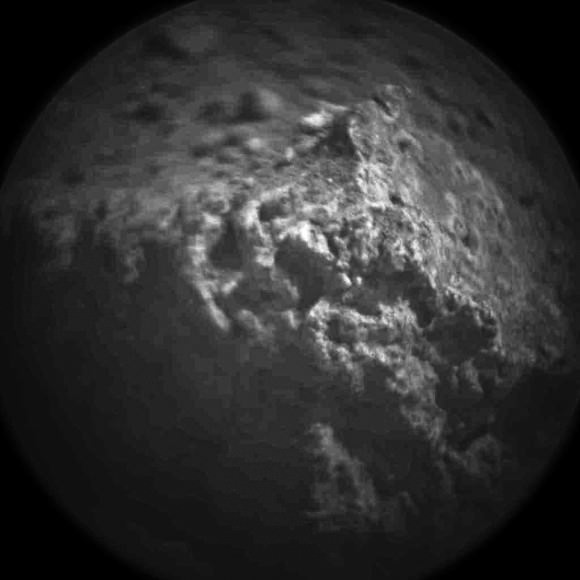This (adjusted) image was taken by ChemCam’s Remote Micro-Imager on Sol 15 (NASA/JPL-Caltech/LANL)
While Curiosity has been getting a good look around its landing spot on Mars, taking in the sights and sending back some impressive views of distant hills and Gale Crater’s enormous central peak, it’s also been peering very closely at some tiny targets just meters away — with its head-mounted, laser-powered and much-touted ChemCam.
The images above and below were acquired by ChemCam’s Remote Micro-Imager on August 21, the 15th “Sol” of the mission. A full-sized image accessed from the public MSL mission site, it’s been brightened quite a bit to show the details of the target rocks.
Mounted to Curiosity’s “head”, just above its Mastcam camera “eyes”, ChemCam combines a powerful laser with a telescope and spectrometer that can analyze the light emitted by zapped materials, thereby determining with unprecedented precision what Mars’ rocks are really made of.
So even though the rover hasn’t actually roved anywhere yet, it’s still performing valuable scientific investigations of Mars — without moving a single wheel. (UPDATE: actually, Curiosity has begun to do some roving — here are some images of its first wheel tracks!)
Read: Curiosity Blasts First Mars Rock with Powerful Laser Zapper
Because ChemCam uses a laser, Curiosity can examine many targets — up to a dozen — within a small time period without having to drive right up to them. Even the dustiest rocks won’t pose a problem for ChemCam – one or two zaps with its laser will be enough to vaporize any loose surface material.
In addition to searching for the building blocks of life hidden inside rocks, ChemCam will also serve a precautionary role for future explorers by helping identify the potential toxicity of Mars’ soil and dust. When astronauts one day land on Mars, they are going to get dusty. It’s important to know if Mars’ dust contains anything dangerous like lead, arsenic (and who knows what else!)
See the latest images from the MSL mission — including more ChemCam pictures — here.
Images: NASA/JPL-Caltech/LANL. Edited by J. Major.



